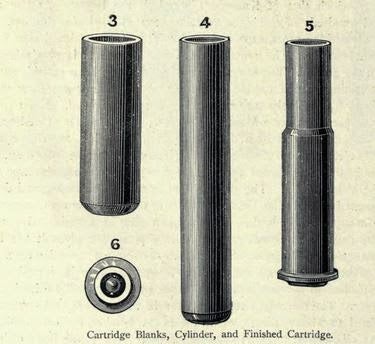The metallic cartridge case underwent significant – though difficult to see – changes in the period between 1860 and 1945. Case metallurgy, manufacturing methods, priming configurations, and even the basic configuration of the metallic case changed and matured during those years. One of the now antiquated methods for making cartridge cases is the subject of a recent Historical Firearms Blog post, featuring plates illustrating the process of drawing brass from a disk into a tubular cartridge case:
In today’s post, we will look at how brass centerfire cartridges were manufactured in the 19th and early 20th centuries. The process we will look at was what was used at Kynoch, a large British manufacturer of ammunition. The brand name “Kynoch” is still used today to sell cartridges, even though they have been merged into a larger company.
The Kynoch factory during this time period, was located in Witton, an inner city area of Birmingham, England. The factory had several hundreds of machines in a single building, turning out cartridges of many shapes and sizes. The machinery used there can be considered as the latest technology for that era.
The process we will study today is what was used to manufacture solid-drawn brass cartridge cases. The first step in the process is to make flat sheets of a type of brass called “cartridge brass”. The brass sheet metal is then taken to a machine that punches out circular blanks from the sheet.
Public domain image.The image above shows a blank to be used to manufacture cartridges for a Mauser rifle. The next step is to put the blank threw a drawing machine, where it is forced through a die with a tapering aperture by a ram under high pressure. This produces an object that is shaped somewhat like a cup or a thimble, as shown below:
Public domain image.Naturally, the pressure applied when shaping the cups puts stress on the metal. Therefore, the cups are then annealed. Annealing is a process of heating the object until it is glowing hot and maintaining the temperature for a while and then letting it cool back slowly to room temperature in a room with no breeze blowing. This softens the metal and removes the internal stresses caused by the shaping process.
Mentioned in the post is the fact that some manufacturer’s still make cartridge cases this way. One such manufacturer is the German company RWS, about which the Field Sports channel made an excellent video showing how they make ammunition (including cases):
 Your Privacy Choices
Your Privacy Choices
